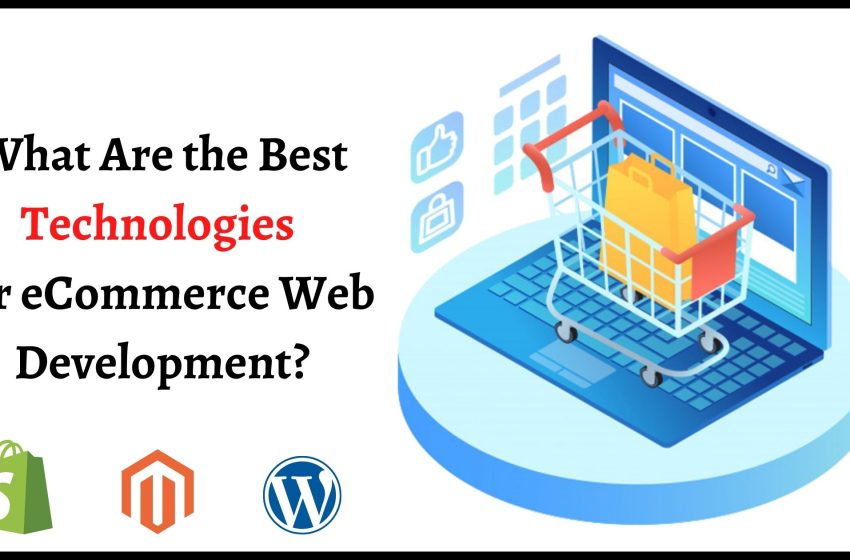What Are the Technologies Behind E-commerce?

The magic of e-commerce lies behind the scenes, with a complex interplay of technologies that facilitate a seamless online shopping experience. All the e-commerce platforms are crafted using these modern technologies that deliver top tier experience to the user and smooth management to the company. In this blog, we will discuss and find out the best technology for ecommerce website development:
-
E-commerce Platforms
These are the foundational building blocks of online stores. They provide a platform for businesses to create their online storefront, manage products, process orders, and accept payments. The best technology for ecommerce website includes popular options like Shopify, WooCommerce, Magento, and BigCommerce.
-
Shopping Cart Systems
Imagine a virtual shopping basket. Shopping cart systems allow customers to add items to their online cart, calculate totals, and proceed to checkout securely. They also manage abandoned carts and integrate with payment gateways.
-
Payment Processing
Secure payment processing is essential for any e-commerce business. Payment gateways connect your online store to various payment processors like Visa, Mastercard, or PayPal, facilitating secure online transactions.
-
Content Management Systems (CMS)
Next technology required for e commerce is its integration with CMS like WordPress, allowing businesses to manage product descriptions, create blog content, and maintain website functionality without needing extensive coding knowledge.
-
Customer Relationship Management (CRM)
CRM systems help manage customer interactions, track purchase history, and personalize the shopping experience. They can also be used for targeted marketing campaigns and improved customer service.
-
Search and Navigation Technologies
Effective site search functionality powered by tools like Elasticsearch or Solr is crucial for users to find products easily. User-friendly navigation menus and faceted search options further enhance the browsing experience.
-
Security Technologies
E-commerce transactions involve sensitive customer data. Secure Socket Layer (SSL) encryption protects data transmission and ensures a safe online shopping environment. Additionally, robust security measures are needed to prevent fraud and cyberattacks.
-
Web Analytics and Tracking
Tools like Google Analytics provide valuable insights into customer behavior on your website. By tracking website traffic, user journeys, and product interactions, businesses can optimize their online store for better conversions.
-
Mobile Commerce Technologies
The rise of mobile shopping necessitates responsive web design that adapts to different screen sizes. Additionally, e-commerce businesses may develop native mobile apps to provide a more personalized and convenient shopping experience for mobile users.
-
Emerging Technologies
The technology required for e commerce is Artificial intelligence (AI) and machine learning (ML) that are transforming e-commerce. Chatbots powered by AI can answer customer queries and personalize product recommendations. Virtual reality (VR) and augmented reality (AR) have the potential to revolutionize product visualization and try-before-you-buy experiences.
Modern Trends in Ecommerce Industry
The e-commerce landscape is constantly evolving, with new trends emerging all the time. Here’s a breakdown of some of the most significant trends shaping the modern e-commerce industry:
Rise of Social Commerce
Social media platforms are no longer just for connecting with friends and family; they’re becoming powerful e-commerce marketplaces. Features like shoppable posts, live streaming commerce, and in-app purchases are blurring the lines between social media and online shopping.
Artificial Intelligence (AI) and Personalization
The next technology required for e commerce is AI. It is being used to personalize the shopping experience for customers. This can include personalized product recommendations, chatbots that answer questions and provide support, and dynamic pricing based on customer behavior.
Augmented Reality (AR) and Virtual Reality (VR)
These immersive technologies are offering innovative ways for customers to interact with products online. AR can allow virtual product try-on experiences, while VR can create 360-degree product views or even virtual store tours.
Summary
By understanding and leveraging these technologies effectively, e-commerce businesses can create a secure, user-friendly, and efficient online shopping experience that keeps customers happy and coming back for more. Refer the options listed above to find the best technology for ecommerce website development.

